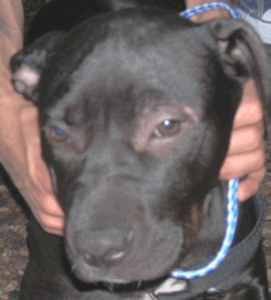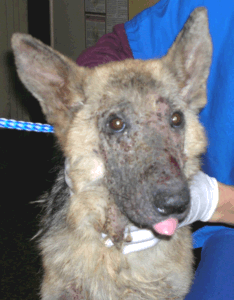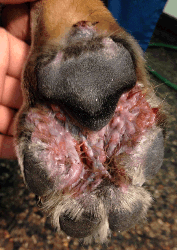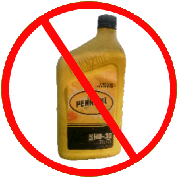|
CANINE DEMODECTIC MANGE

(SOMETIMES CALLED "RED MANGE" OR “DEMODICOSIS”)
FOR INFORMATION ON DEMODECTIC MANGE IN THE CAT: FELINE DEMODECTIC MANGE
THE CULPRIT - DEMODEX CANIS
|

(original graphic by marvistavet.com)
|
Demodectic mange, also called "demodicosis," is caused by one of the microscopic mites of the Demodex genus. Three species of Demodex mites have been identified in dogs: Demodex canis, Demodex gatoi, and Demodex injai. The most common mite of demodectic mange is Demodex canis. All dogs raised normally by their mothers possess this mite as mites are transferred from mother to pup via cuddling during the first few days of life. Most dogs live in harmony with their mites, never suffering any consequences from being parasitized. If, however, conditions change to upset the natural equilibrium (such as some kind of suppression of the dog's immune system), the Demodex mites may "gain the upper hand." The mites proliferate and can cause serious skin disease.
IS DEMODICOSIS CONTAGIOUS?
Demodectic mange (unlike Sarcoptic mange) is not considered a contagious disease and isolation of affected dogs is generally not considered necessary. That said, there are some circumstances under which the mites could spread from one dog to another. Classically Demodex mites have been felt to only be transferable from mother to newborn pup. After the pup is a week or so old, it has developed enough immunity so that infection is no longer possible. In other words, after age one week or so, a dog will not longer accept new mites on its body. Recently this idea has been challenged as occasionally multiple unrelated dogs break with demodicosis in the same household. It is not clear if some species of Demodex are more contagious than others or if some contagion is possible under certain circumstances. Current thinking is that mites actually can be transferred from one dog to another but as long as the dog is healthy, the mites simply add into the dog's natural mite population and no skin disease results. In rare circumstances spread of disease is possible if a very severe infection is involved. While there are still assorted theories about dog to dog transmission of Demodex mites, there is no question that mites cannot be transmitted to humans or to cats.
|
|
- Mites live inside hair follicles -- a difficult place for miticides (chemicals that kill mites) to reach.
- Mites are a normal residents of dog skin; it is only in some individual dogs that mites cause problems.
|
DEMODICOSIS HAS THREE FORMS
FORM #1: LOCALIZED
|
Localized demodicosis occurs as isolated scaly bald patches, usually on the dog's face, creating a polka-dot appearance. Localized demodicosis is considered a common puppyhood ailment and approximately 90% of cases resolve with no treatment of any kind. This is quite a contrast to generalized demodicosis as described below so it is important to be able to distinguish localized from generalized disease. It seems like this would be a simple task since localized demodicosis classically involves several round facial bald spots and generalized demodicosis involves a bald scaly entire dog; still, reality does not always fit into neat categories in this way. Some guidelines used to distinguish localized demodicosis include:
|

(original graphic by marvistavet.com)
|
- Localized disease does not involve more than two body regions. (One spot or two on the face and one spot or two on a leg would still qualify as localized even though the spots are not close together.)
- Localized disease involves no more than 4 spots total on the dog.
|

(original graphic by marvistavet.com)
Puppy with localized demodicosis
around her left eye
|
Treatment is not necessary on recommended for localized demodicosis but there are so many regular flea products that kill Demodex mites that most puppies will clear simply by starting their normal prescription flea control regimen. Not all flea products will kill Demodex; one needs a product of the isoxazoline class and the puppy must be old enough for such a product.
If there is a reason why the puppy cannot take an isoxazoline flea product, there are alternatives. Goodwinol ointment, an insecticide ointment, may be used daily to control localized demodicosis. Antibacterial gels are also used against localized demodicosis and associated skin infections. It is important to note that rubbing a creme or ointment on a demodicosis lesion can cause reddening of the lesion making it appear to get worse. It is also possible for rubbing the medication on the area to break off the weaker hairs at the margin of the lesion causing the lesion to appear to get bigger. Neither of these situations truly represents exacerbation of the disease.
Without treatment, resolution of a localized demodicosis lesion should be at least partially apparent after one month though total resolution can take up to three months.
Approximately 10% of localized demodicosis cases will progress to generalized demodicosis. Enlarged lymph nodes are a bad sign -- often foretelling generalized mange.
|
CAN THE PUP BE BRED LATER?
Sometimes the puppy with localized demodicosis was obtained for breeding purposes. The current recommendation is not to treat these puppies so that we can determine if the condition will stay localized and resolve or if it will generalize. If it stays localized and eventually resolves without treatment, the animal is still a candidate for breeding. If the condition generalizes to cover the entire body, the animal should be sterilized. If the condition receives treatment and resolves, we will never know how the disease would have gone in its natural state and will not know whether the pup is carrying the genetic predisposition for generalized demodectic mange. In this case, it is best to be conservative and not take the chance of passing on genetic predisposition for this disease.
Localized demodicosis is almost exclusively a "puppyhood" disease. When a puppy develops localized demodicosis the chance of the condition resolving is 90% unless there is a family history of demodicosis in related dogs. In this case, chance of spontaneous resolution drops to 50%.
Occasionally an adult dog develops localized demodicosis. We currently do not have good understanding of the prognosis or significance of this condition in an adult dog.
|
FORM #2: GENERALIZED
Generalized demodicosis entails much more extensive involvement of the skin. Large patches of skin are affected and, if allowed to progress untreated, the entire surface of the dog may be impacted. Sometimes a polka dot appearance results but if there are more than 4 spots present, the patient is no longer classified as having the "localized" form and treatment rules for generalized disease may be applied. The secondary bacterial infections make this a very itchy and often smelly skin disease. These infections may require antibiotics but it is important to realize that infection will probably not resolve fully until the mites are gone.
THE GOAL OF TREATMENT IS TOTAL ERADICATION
OF THE MITE POPULATION ON THE DOG'S BODY.
JUVENILE ONSET (THE MOST COMMON FORM) -- Young dogs that develop demodicosis are believed to have a genetic immunological defect that allows the mite to gain the upper hand. As the puppy grows up and his or her immune system matures, the immune system tend to naturally regain control of their mite infestation; in fact, 30-50% of dogs under age 1 year recover spontaneously from generalized demodicosis without any form of treatment. Usually treatment is recommended, though, to facilitate recovery.
|

(original graphic by marvistavet.com)
Dog with generalized demodicosis
|
ADULT ONSET-- Most demodicosis occurs in young dogs, under age one and a half. An older dog should not get demodicosis unless he or she has an underlying problem with the immune system. In such cases, demodicosis is considered a indication to seek a more serious hidden condition such as cancer, liver or kidney disease, or an immune-suppressive hormone imbalance. A more extensive medical work-up will be required. In the case of shelter dogs, sometimes the stress of abandonment, street living, starvation or other poor husbandry can compound into the immune suppression needed to generate a case of adult onset demodectic mange.
In older times, generalized demodicosis was nearly untreatable and many dogs were euthanized for uncontrollable disease. In the present, treatment for most dogs is surprisingly simple.
IT IS VERY IMPORTANT THAT DOGS WITH A HISTORY OF GENERALIZED
DEMODECTIC MANGE NOT BE BRED AS THERE IS A HEREDITARY
COMPONENT TO THE DEVELOPMENT OF THE DISEASE.
TREATMENT
The biggest change in treating this condition came, as mentioned, with the release of the isoxazoline flea products (sarolaner/Simparica®, fluralaner/Bravecto®, afoxalaner/Nexgard®, lotilaner/Credelio®). The isoxazoline products are oral medications labeled to kill fleas and ticks in dogs. It turns out they have substantial activity against Demodex mites and are successful enough that they have become treatment of choice. These products are typically given orally every two to four weeks depending on the protocol. Most dogs are simply cured by this protocol.
Occasionally, a dog fails this treatment as is relegated to the more traditional methods such as high dose oral ivermectin, a protocol which is not safe for many herding breeds, topical moxidectin (Advantage multi®), daily oral milbemycin (Interceptor®) or even labor intensive dipping with amitraz (mitaban®).
It should be mentioned that the common anti-itch medication oclacitinib (Apoquel®) highly promotes the success of demodex mites and should be avoided no matter how itchy the patient is. Other forms of itch relief should be sought if necessary. Oclatacinib use can actually lead to a recurrence of demodicosis years after recovery so it should not be used in any dog that has ever suffered from demodicosis previously.
STRESS AND GENERALIZED DEMODECTIC MANGE
The treatment of demodicosis only in part relies on medications; some basic steps can be taken with regard to pet care to maximize the chance of success. Physiological stress is an important factor determining the degree of severity of demodectic mange and the following steps should be taken to reduce stress:
- Females should be spayed as soon as the disease is controlled. Coming into heat, hormone fluxes, and pregnancy are very stressful and will encourage the mites. Also, predisposition to demodicosis is hereditary and should not be passed on.
- The dog should be fed a reputable brand of dog food so as to avoid any nutritionally related problems.
- Keep the pet parasite-free. Worms are irritants that the pet need not deal with and fleas may exacerbate the itchiness and skin infection.
- Keep up the pet's vaccinations.
- The mites themselves cause suppression of the immune system so the pet needs every advantage to stay healthy.
- Skin infections are usually present in these cases and antibiotics will likely be necessary. It is very important that cortisone type medications such as prednisone NOT be used in these cases as they will tip the immune balance in favor of the mite.
PROGNOSIS
The younger the dog, the better the chance of cure. Most dogs under one year and a half years of age, recover completely from generalized demodicosis. In many cases of adult-onset demodicosis, the disease is controlled with treatment but cure is not always possible. Some cases can never be controlled.
No matter which option you choose, treatment should be accompanied by skin scrapes every two to four weeks. In this way the effectiveness of treatment is assessed and dosing can be changed. There are several protocols published describing how to determine if treatment can be stopped. The idea is to eradicate every single mite from the dog's body so that the condition cannot recur. This typically entails either continuing treatment for a significant time after the patient appears recovered and/or rechecking skin scrapes a significant time after treatment has finished.
RELAPSE?
When relapse occurs it is often because the dog appeared to be normal and treatment was discontinued before all Demodex mites were killed off. Relapse is always a possibility with generalized demodicosis as there is no easy way to confirm that every mite has been killed but most dogs that relapse do so within a 6-12 month period from the time they appear to have achieved cure.
SARCOPTIC MANGE IS A COMPLETELY DIFFERENT DISEASE.
Click here for information on Sarcoptic mange.
|
FORM #3: DEMODECTIC PODODERMATITIS
This condition represents demodectic mange confined to the paws. Bacterial infectious usually accompany this condition. Often as generalized demodicosis is treated, the foot is the last stronghold of the mite. Old English Sheepdogs and Shar pei tend to get severe forms of this condition. The infection can be so deep that biopsy is needed to find the mites and make the diagnosis. It is one of the most resistant forms of demodicosis and the deep infections and proliferative tissue that result
In the past, special organophosphate foot soaks along with daily medications were needed to resolve this condition and months of treatment were common. As with the other forms of demodicosis, the isoxazoline flea products (sarolaner/Simparica®, fluralaner/Bravecto®, afoxalaner/Nexgard®, lotilaner/Credelio®) have changed everything. In most cases, the mites can be quickly killed and the deep secondary infections can be resolved in a matter of weeks (instead of months) once the mites are gone.
|

An affected paw.
(original graphic by marvistavet.com) |
|
WE WISH IT WASN’T NECESSARY TO ADD THIS
In older times, decades ago before there were effective medications, dipping dogs with demodectic mange in motor oil was a popular home remedy. Skin exposure to motor oil can cause rashes and skin destruction in severe cases. The hydrocarbons can be absorbed through the skin and cause a dangerous drop in blood pressure. If motor oil is licked off the coat, resultant vomiting can lead to aspiration of motor oil into the lungs and pneumonia. Kidney and liver damage can result from motor oil dipping.
PLEASE: DO NOT DIP YOUR DOG IN MOTOR OIL!
|

|

Page last updated: 10/28/2024
|